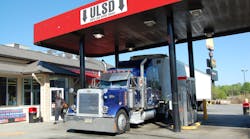The average price of diesel in the U.S. increased 5.6 cents to $4.15 per gallon this week, according to data tracked by the Energy Information Administration (EIA) – adding that expectations for a “normal” cold winter is already boosting demand for heating oil, which could lead to further hikes diesel fuel prices as both are made from the same petroleum distillate stock.
EIA also noted that diesel prices increased in every region of the U.S., with the Midwest suffering the largest spike as prices jumped 11 cents to $4.15 per gallon, followed by the Rocky Mountain region (a 7.4 cent increase to $4.268 per gallon) and the Lower Atlantic area (a 3.8 cent hike to $4.047 per gallon).
Altogether, the $4.15 per gallon average price for diesel this week is 34.9 cents higher compared to the same week in October last year, the agency pointed out.
Conversely, gasoline prices fell in all but three regions of the U.S., dropping 3.3 cents to an average of $3.819 per gallon for the U.S. The cost of gasoline only increased in the Lower Atlantic (a 2.4 cent rise to $3.691 per gallon), on the West Coast without including California (a 1,3 cent increase to $3.991 per gallon) and along the Gulf Coast (a 7/10ths of a penny jump to $3.544 per gallon).
The price of gasoline plunged the most in the Midwest, dropping 8.7 cents to $3.685, followed by the Central Atlantic region (a 3.4 cent decline to $3.877 per gallon). Altogether, though, this week’s national average price for gasoline remains 34.3 cents more expensive per gallon compared to the same week in 2011, the agency added.
A return to “nominal” winter temperatures is also expected to drive up energy consumption and prices – especially for heating oil, which could put upward pressure on diesel prices as a result.
The EIA said its forecast for higher household energy expenditures – detailed in its Short Term Energy Outlook (STEO) released this week – primarily reflects a return to roughly normal winter temperatures east of the Rocky Mountains compared with last winter's unusual warmth.
According to the National Oceanic and Atmospheric Administration (NOAA), the Northeast, Midwest, and South will be about 2% warmer than the 30-year average (1971 - 2000), but still 20% to 27% colder than last winter, while the West is projected to be only about 1% colder than last winter.
As a result, EIA projects average household expenditures for heating oil and natural gas will increase by 19% and 15%, respectively, this winter – which encompasses from October 1 through March 31 in the agency's report – compared with last winter.
More importantly, average expenditures for households that heat with heating oil are forecast to be higher than any previous winter on record, with the residential heating oil prices predicted to average 2% higher this winter, with natural gas prices averaging 1% higher.
By contrast, average electricity and propane prices are expected to average about 2% and 4% lower than last winter, respectively, according to the agency’s calculations.
“Households heating primarily with heating oil are expected to spend an average of about $407 or 19% more this winter than last winter as a result of that 2% increase in prices and 17% increase in consumption,” EIA noted in its STEO report.
“About 6% of U.S. households depend on heating oil for space heating; however, the Northeast accounts for about 80% of these households,” the agency said. “Low distillate stocks in the East Coast and Gulf Coast states, which provide over 60% of the Northeast's distillate supply, and the state of New York's switchover from higher sulfur heating oil to fuel with less than 15 parts per million sulfur, all contribute to an expected tighter market this winter.”



